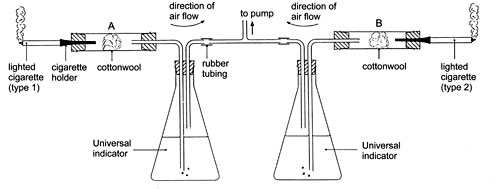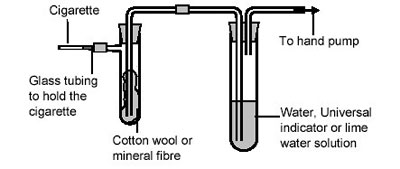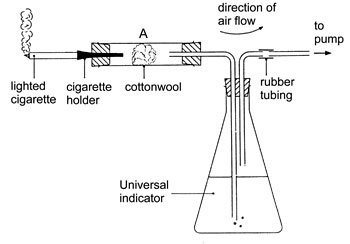Going up in smoke
Class practical
Establish the effect of unlit cigarettes on the apparatus by running the filter pump for 10 minutes. (There should be no effect.) Smoke at least two different cigarettes, and compare their effect on the white-coloured mineral wool and on the indicator solution.
Lesson organisation
This procedure should be carried out in a fume cupboard as a teacher demonstration.
Apparatus and Chemicals
Apparatus as in alternative diagrams shown below:
Conical flask, 250 cm3, 1 or 2
Glass tubes, bent to right angles, 2 or 4 (Note 2)
T-piece, glass
Rubber bungs, two-holed, 1 or 2
Hard glass tube, shaped to hold a cigarette,
1 or 2
White-coloured mineral wool, superwool, glass wool or polymer wool for aquarist filters
Alternatives/ additions:
Connector to allow thermometer to be held in the smoke stream near the cigarette
U-tubes containing white-coloured mineral wool to replace tubes A and B
Hydrogencarbonate indicator (equilibrated with air) in place of Universal indicator.
For the class – set up by technician/teacher:
Filter pump or hand-operated vacuum pump (Note 1)
Clamp stand, boss and clamp, 2
Matches
Dishes to collect ash from cigarettes

Health and Safety and Technical notes
Carry out the procedure in a fume cupboard.
It is essential to avoid skin contact with the tars collected.
Read our standard health & safety guidance
1 If your water supply does not support a filter pump, use a hand-operated vacuum pump, or a syringe to draw air through the apparatus
2 Check that the tips of the longer glass tubes are below the surface of the indicator solution, and that the shorter glass tubes are well above the surface even if the liquid bubbles.
3 Disassemble the apparatus in a fume-cupboard avoiding skin contact with the tars. Wear protective gloves (preferably nitrile). Place the tar-soaked material in a plastic bag which is sealed before disposal with normal refuse. Wipe the glass with a paper towel soaked in a suitable solvent, such as ethanol (FLAMMABLE) and dispose of the paper towel with the tarry wool. The apparatus is difficult to clean, so re-use in future years. Store in a box or sealed plastic bag to contain the smell. (See CLEAPSS Laboratory Handbook.)
Ethical issues
Cigarettes and smoking provide a rich context for ethical discussions. The first reported research indicating links between lung cancer and cigarette smoking was published in 1950, and in the UK smoking has been banned in public places. There is scope for debate about our rights to make risky lifestyle choices as well as the responsibility of government to promote public health. The commercial drive of tobacco companies and the tax revenue to government from tobacco sales are factors that could influence the reliability of information from different sources. It is hard to find information presented impartially on the subject of smoking and cancer. It is worth trying to identify who has funded or supported any piece of reported impartial or scientific research.
Procedure
SAFETY: Cigarette packets carry health warnings. Schools and colleges are usually non-smoking premises on the grounds of the stated health risks of cigarette smoke. Set up the apparatus in a fume cupboard, and avoid contact with the smoke or close contact with the contents of the tubes at the end.
Parts of the apparatus near the cigarette may be hot at the end, so take care when disassembling to weigh the tubes.
Preparation
a Find the mass of tubes A and B, and write the masses on paper associated with the apparatus.
Investigation
b This is often set up with one lit cigarette and the second unlit as a control. Consider running air through 2 unlit cigarettes (of different types) for 10 minutes to establish that this has no visible effect on the cotton wool or the indicator. Then you could use the apparatus to compare two different types of cigarette – for example normal and low tar, the same brand with and without its filter, packet cigarette vs hand-rolled.
c Start the filter pump. Light the cigarette/s and run until the cigarette is nearly smoked.
d Switch off the filter pump and see what happens to the final few millimetres of cigarette. (This will be particularly interesting if you are comparing packet cigarette with hand-rolled, as rolling tobacco contains fewer ingredients to keep it burning.)
e Note the visible changes to the cotton wool and the indicator.
f Find the mass of tubes A and B. Calculate the increases in mass.
g Disassemble the apparatus avoiding skin contact with the tar (Note 3).
Teaching notes
This demonstration makes a good starter activity for the subject of smoking. Students may be surprised at the amount of tar collecting in the mineral wool from just one cigarette. If you want to pass the wool around for students to smell (which can have a dramatic impact), remove it from the tube using a spatula and put it in a beaker to remove the risk of students touching the tar.
Effects of tobacco smoke on the body:
- Smoke from tobacco paralyses cilia in the trachea and bronchi for approximately an hour after a cigarette has been smoked.
- Dry dust and chemicals in the smoke irritate the lungs, causing more mucus to be secreted. Cilia normally sweep this mucus away, but smoke has paralysed them. Mucus builds up and if this becomes infected it can cause bronchitis.
- Tar is a dark brown, sticky substance, which collects in the lungs as the smoke cools. It contains carcinogens – chemical substances known to cause cancer.
- Carbon monoxide is a gas which combines with haemoglobin, the oxygen-carrying substance in the red blood cells, even more readily than oxygen does. So it reduces the oxygen-carrying capacity of the blood by as much as 15% in heavy smokers. Unlike the reaction with oxygen, the reaction is irreversible.
- Nicotine is the addictive drug that makes smoking such a hard habit to give up. It is responsible for the yellow staining on a smoker's fingers and teeth. Nicotine can harm the heart and blood vessels too – it makes the heart beat faster, the blood pressure rise, and the blood clot more easily.
It is hard to find information presented without an agenda on the subject of smoking and cancer. There are links below to a range of sources of information.
As with many issues relating to health and lifestyle choices, it is difficult to isolate the effects of any individual factor. Some reports indicate connections with socio-economic profiles that may also significantly influence health.
There is scope to discuss the meaning of risk measurements, and to try to track down original research papers in order to assess their methodology.
There is a link below to a report on the detailed analysis of the contents of the smoke from a range of brands. This is an independent analysis presented on the Tobacco Manufacturers' website. It doesn’t connect the smoke contents to specific health risks, but it does mention using ISO conditions for smoking cigarettes (ISO 3308:2000). The idea of an ISO standard routine analytical cigarette-smoking machine might interest some students. The smoking machine puffs with a puff volume of 35 ± 0.2 cm3, and with a 2.0 ± 0.02 second puff duration once every 60.0 ± 0.5 seconds.
The ISO standard machine makes a much more detailed analysis than the apparatus suggested above. The instructions for a smoking machine that would be acceptable for an ISO accredited test list 24 factors which must be controlled or measured by the machine. These include:
- puff duration – the length of time during which the port is connected to the suction mechanism: 2.00 ± 0.2 seconds
- puff volume – the volume leaving the butt end of the cigarette and passing through the smoke trap
- puff frequency – the number of puffs in a given time: one puff every 60 ± 0.5 seconds measured over 10 consecutive puffs
- dead volume – the volume which exists between the butt end of the cigarette and the suction mechanism
- draw resistance – negative pressure applied to the butt end under test conditions to sustain a volumetric flow of 17.5 cm3/ s, exiting the butt end when the cigarette is encapsulated in a measurement device to a depth of 9mm
Ask students to evaluate your apparatus compared with this list of factors. What difference do you think it makes if the apparatus smokes continuously or puffs the cigarette? Why is it important that there is an internationally-recognised standard way of assessing cigarettes?
 Evaluate your apparatus compared with this diagram.
Evaluate your apparatus compared with this diagram.
Some reports of cigarette analysis refer to NFDPM – which is nicotine free dry particulate matter, otherwise known as “tar”. TPM stands for total particulate matter.
Health and safety checked, September 2008
Web links
http://www.the-tma.org.uk/benchmark/covering_letter.htm
This connects to the UK Benchmark study report of an analysis of tobacco from cigarettes on the market in the UK. (Scroll to the bottom of the page for links to reports). The Final report explains the methodology of the analysis. There is a summary on p5 of Part 1 of the report which lists all brands tested and the components of their smoke.
http://webarchive.nationalarchives.gov.uk/+/www.dh.gov.uk/en/Publichealth/Healthimprovement/Tobacco/index.htm
The Department of Health information about tobacco and health on their now archived site
http://www.ash.org.uk/
Action on Smoking and Health (ASH) is a campaigning public health charity that works to eliminate the harm caused by tobacco.
http://www.forestonline.org/
Forest is a media and political lobby group. Their purpose is to protect the interests of adults who choose to smoke or consume tobacco in its many forms.
http://info.cancerresearchuk.org/cancerstats/causes/lifestyle/tobacco/
Cancer Research UK is the leading funder of cancer research in the UK and has stated goals of improving the lives of cancer patients and helping people to understand the choices they make.
http://www.beep.ac.uk/content/493.0.html
Beep is the Bioethics Education Project. This link takes you directly to the pages on tobacco and health risks and choices.
Doll, R. and A.B. Hill, Smoking and carcinoma of the lung. Preliminary report. British Medical Journal, 1950: p. ii:739-48.
http://www.ncbi.nlm.nih.gov/pubmed/15292933?dopt=Abstract
Abstract of ‘The cumulative risk of lung cancer among current, ex- and never-smokers in European men’ – referenced on Cancer Research UK website.
http://www.ncbi.nlm.nih.gov/pubmed/15741188?dopt=Abstract
Abstract of ‘Estimate of deaths attributable to passive smoking among UK adults: database analysis’ – referenced on Cancer Research UK website.
(Websites accessed October 2011)



